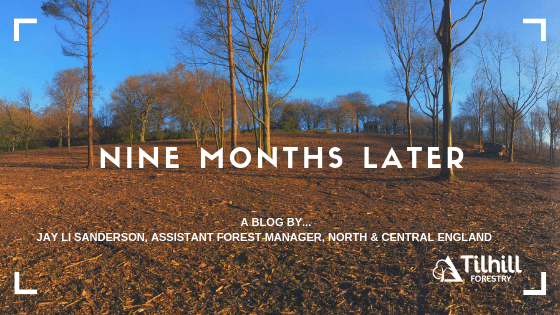As the title suggests, July marks nine months since I began the graduate scheme with Tilhill Forestry. It has gone very quickly. Partly, I think due to the natural stratification of a forester’s year, which is quite refreshing, having previously been in a vocation where days ran into weeks, which turned into months, with no hope of interest or variation (read my first blog here). As a forester, it seems the year is broken up quite nicely. It ensures you keep on task current jobs in order to meet deadlines, whilst also planning for work that is soon to commence. The most rewarding aspect of the initial period of the graduate scheme has undoubtedly been the variety of work which I have been lucky enough to observe and be involved with.
I have so far traversed a wide gamut of ground preparation techniques; navigated through the logistical web that is the planting season; negotiated summer and winter chemical applications, monitored working conditions and comprehended fluctuating results. All interspersed with harvesting operations and ecological constraints thrown in for good measure. More specifically, to date I have co-managed woodland creation schemes; felling and thinning operations; mechanical clearance works; beat-up operations; chemical weeding operations; parkland restorations; invasive species control, mapping; ecological species mapping; annual property inspections and generated tree survey reports for clients. I have also been entrusted with the sole management of small new planting schemes, grant funded gap hedge planting and various funding and license applications.
One very enjoyable aspect of my early career with Tilhill Forestry has been getting out to as many sites as possible and getting to know the area.. I have been fortunate enough to have observed a wide range of forestry machinery in action and gained an appreciation of the importance of using the right machine for the job. This is not only true in terms of the final result but also in order to realise peak productivity and efficiency. To this end, I have recognised the significant value of knowing what services contractors can offer and, perhaps more importantly, choosing the right contractor for the right job. A fundamental skill, which can be improved upon quickly when good relationships are built with contractors and their teams.
With this in mind, one job that stands out from all others was a parkland restoration job, that Tilhill Forestry managed for Leeds City Council. This project was located within an inner-city park, not exactly the kind of setting I imagined myself working in a forestry capacity. The intention was to open a vista from ‘Temple Newsam House’ to the ‘Little Temple’ which was in an elevated position 730m due east of the main house. This landscape was quite interestingly remodelled by Lancelot ‘Capability’ Brown between 1765 and 1771 for the 9th Viscount Irwin for a fee of £40! It was a feature of this landscape design that the project sought to restore.
The Temple Newsam Parkland Restoration stands out above others partly due to the potential risks and problems that would need to be navigated, in order to achieve our goal of a safe and successful restoration. These ranged from security and antisocial behaviour concerns, public access and on-going public events, through to environmental, infrastructure and weather constraints. Careful selection of the contracting teams was a pivotal part of the overall success, as was maintaining a management presence on site to provide information to the public on a face to face basis, which allowed our contractors to push on and make progress. Additionally, organising closure and diversions of public footpaths, bike paths and bridleways, setting up of barriers and information boards and intensive daily perimeter checks were a key to keeping the public informed and safe, whilst the restoration work was being carried out. Machinery was taken to a local secure facility on a nightly basis via tractor and trailer. This resulted in slowing the job down considerably but was imperative at the same time. Once the felling and thinning work on site was completed, brash was raked and chipped before being mulched with a Raptor 300 to provide the best finish possible.
This particular project taught me that on sites which have significant constraints and challenges, selecting the correct contractor and equipment along with a positive and proactive management approach are imperative. With all this in place then exceptional outcomes can be achieved.




